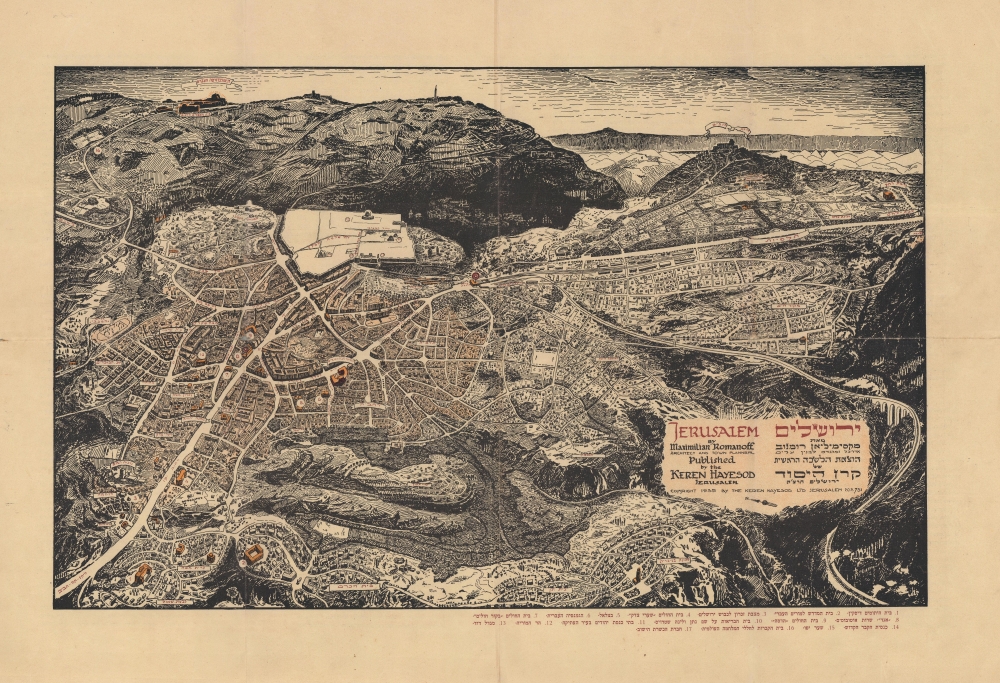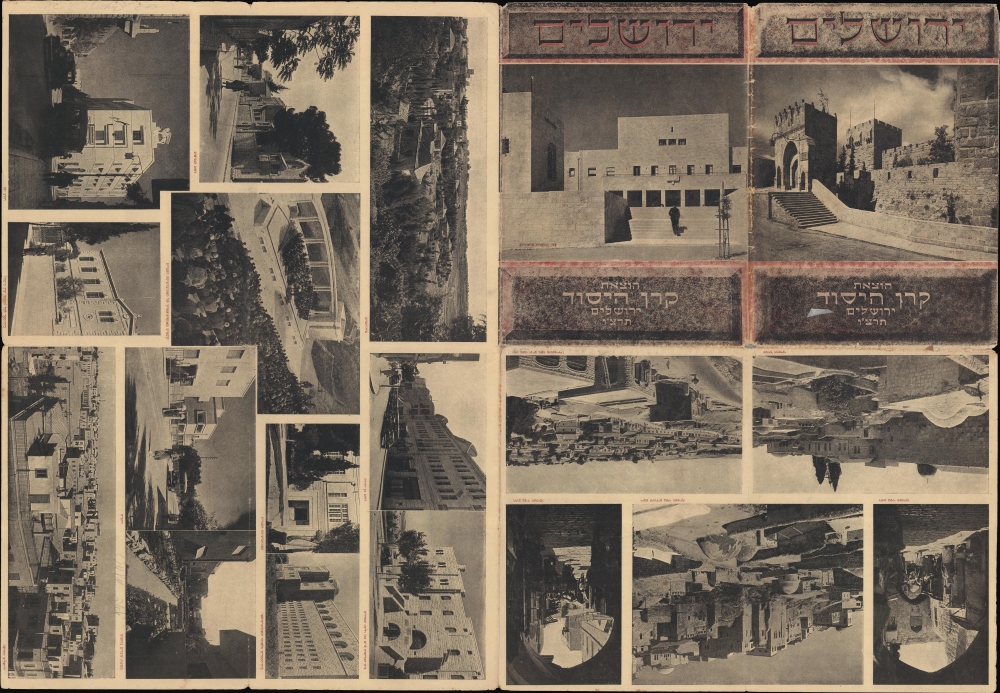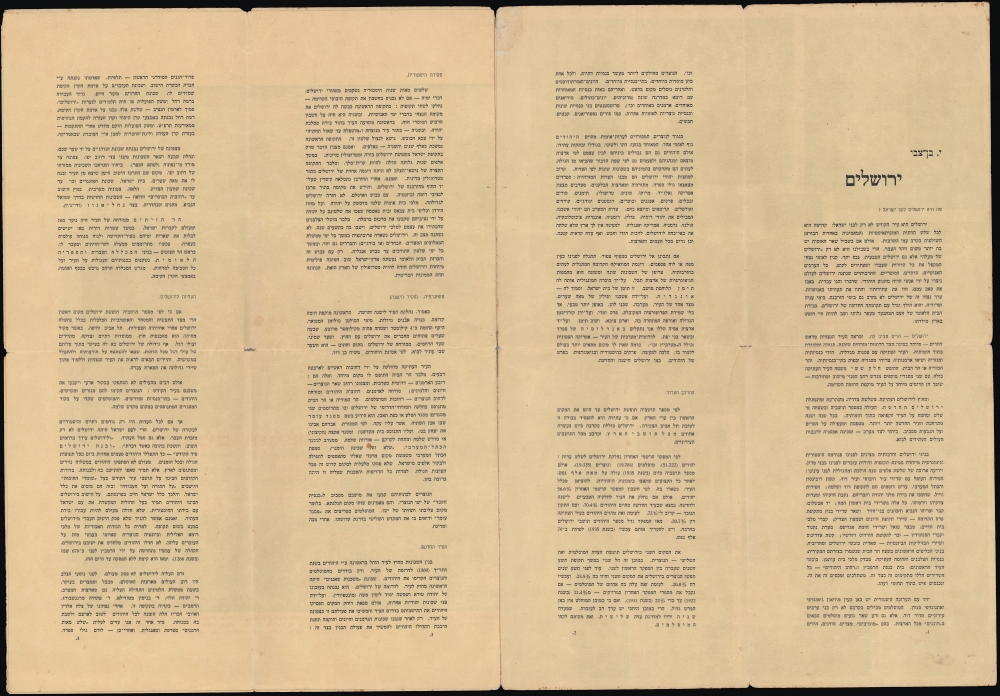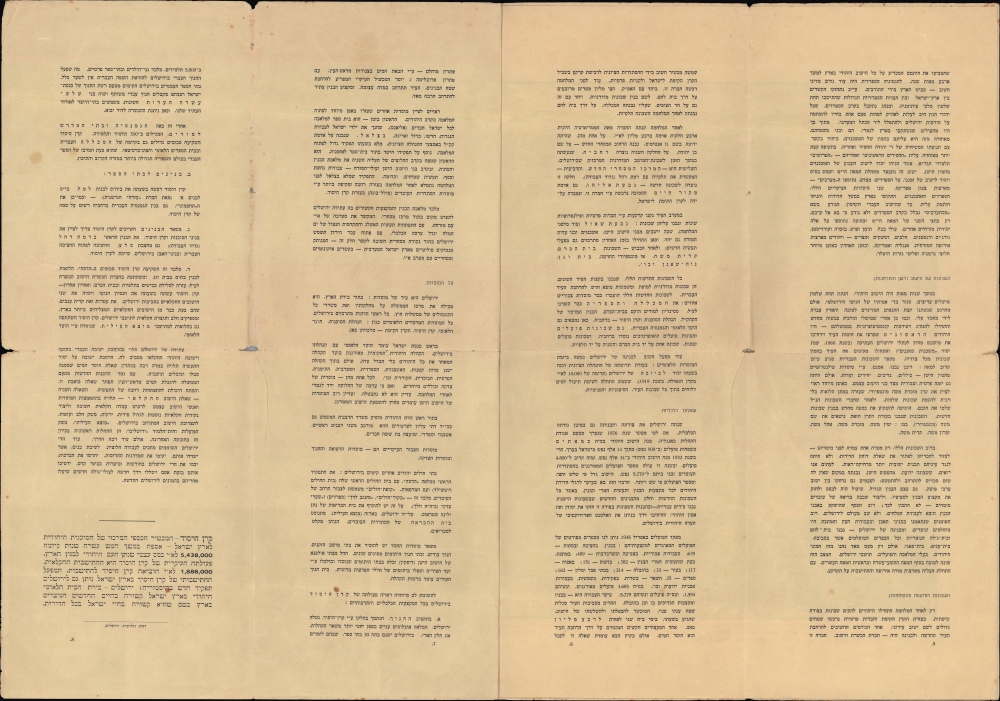This item has been sold, but you can get on the Waitlist to be notified if another example becomes available, or purchase a digital scan.
1935 Romanoff Hebrew Pictorial View of Jerusalem
Jerusalem-romanoff-1935
Title
1935 (dated) 17.5 x 25.25 in (44.45 x 64.135 cm)
Description
A Closer Look
Oriented towards the east-northeast, this view takes in the heart of Jerusalem, including but not limited to the Old City, which is lightly shaded in orange. Historical and contemporary sites are labelled either on the view itself or with numbers corresponding to an index at bottom-right. The Temple Mount, Wailing Wall, and Dome of the Rock are readily noticeable towards top-left, though the latter site is not identified. The Hebrew University of Jerusalem stands prominently on the hill at top-left, while other large and well-known institutions like the Rockefeller Museum and Y.M.C.A. are easily recognizable. Synagogues, hospitals, settlements, the 'Maccabee Ground' stadium, and historical sites are all labelled. The verso includes photographs of the sites noted on the recto, while an accompanying text in Hebrew by Yitzhak Ben-Zvi chronicles the city's history and present status from a Zionist perspective.Mandatory Jerusalem (1917 - 1947)
The British captured Jerusalem from the Ottomans on December 11, 1917, drastically altering the historical trajectory of the city. Under the British 'Mandate,' the city grew significantly, especially outside of the Old City, and took on many characteristics of British imperial outposts elsewhere; new public institutions (universities, hospitals) were built and regulations put into place around urban planning and architecture.However, the British also had to contend with the maddening issue of inter-communal violence. The Balfour Declaration all but required the Mandate to encourage the Jewish immigration, a disproportionate number of whom settled in Jerusalem. Even before the Mandate, Jewish migrants had settled in the city in significant numbers, but Ottoman land records were spotty, leaving the British with the task of sorting out competing property rights.
The result was that the Mandate period was consumed with policing violence between Jews and Arabs, as well as supporting Zionism in principle while also opposing the more ardent, armed Zionist groups seeking an independent Israel. These contradictions in British policy set the stage for the post-World War II creation of the State of Israel and the continued disputes over its territory lasting to the present day.
Publication History and Census
This map was drawn by Maximilian Romanoff, noted here as an 'architect and town planner,' though little information on his life and other works can be found. It was published by the Keren Hayesod, with the text portion written by Zionist leader and historian Yitzhak Ben-Zvi. There are at least five printings of the map in two editions (1935 and 1936), the present one as well as printings in which the index at bottom and text by Ben-Zvi are in English, German, French, and Polish, respectively. This Hebrew-language printing looks to be the rarest, with only the National Library of Israel noting it among their institutional holdings.CartographerS
Keren Hayesod (1920-present), קרן היסוד, known in English as United Israel Appeal of 'the Foundation Fund,' was founded at the World Zionist Congress in London in July 1920 to provide funds for Zionist movement, with a focus on establishing a Jewish homeland in Palestine. Early leaders of the group included Chaim Weizmann, Albert Einstein and Ze’ev Jabotinsky. Keren Hayesod has been involved in the building of entire communities in Israel, especially for refugees fleeing Anti-Semitism, including escapees from European concentration camps during the Second World War. The organization played a role in establishing the Hebrew University of Jerusalem, the Israel Philharmonic Orchestra, and Bank Hapoalim. After the foundation of Israel, Keren Hayesod was instrumental in housing thousands of Jewish refugees from nearby countries. More by this mapmaker...
Yitzhak Ben-Zvi (יִצְחָק בֶּן־צְבִי; November 24, 1884 - April 23, 1963) was a historian, ethnologist, Zionist leader, and President of Israel. His was born in Poltava in Ukraine and his father, Zvi Shimshelevich, was one of the organizers of the first Zionist Congress in Basel in 1897, and the only organizer of the congress to live to see the foundation of the State of Israel. But for their political organizing, Yitzhak's father and mother were exiled to Siberia. Ben-Zvi briefly studied at Kiev University but dropped out to focus his efforts on the Poale Zion, a Marxist Zionist organization he co-founded. Facing political persecution in the Russian Empire, he emigrated to Palestine in 1907. In Jerusalem, Ben-Zvi was deeply involved in the Zionist movement and became an ally of David Ben-Gurion. He also undertook impressive scholarly efforts to document the language and culture of the Jewish communities of Palestine, and of Mizrahi and Sephardic communities more broadly, as well as the Samaritans. From 1919, he abandoned Marxism for democratic socialism, became more strident in his stance towards the Arab community, and was active in the paramilitary organization Haganah (he was an Arabic speaker who had earlier advocated a union of the Jewish and Arab 'proletariat' in Palestine). He also entered formal politics, serving on the Jerusalem City Council and as president of the Jewish National Council. Ben-Zvi also continued his scholarly work, and played a central role on the Government Naming Committee after the establishment of Israel. In 1952, he was elected the second president of Israel, a post which he held until his death. Learn More...








